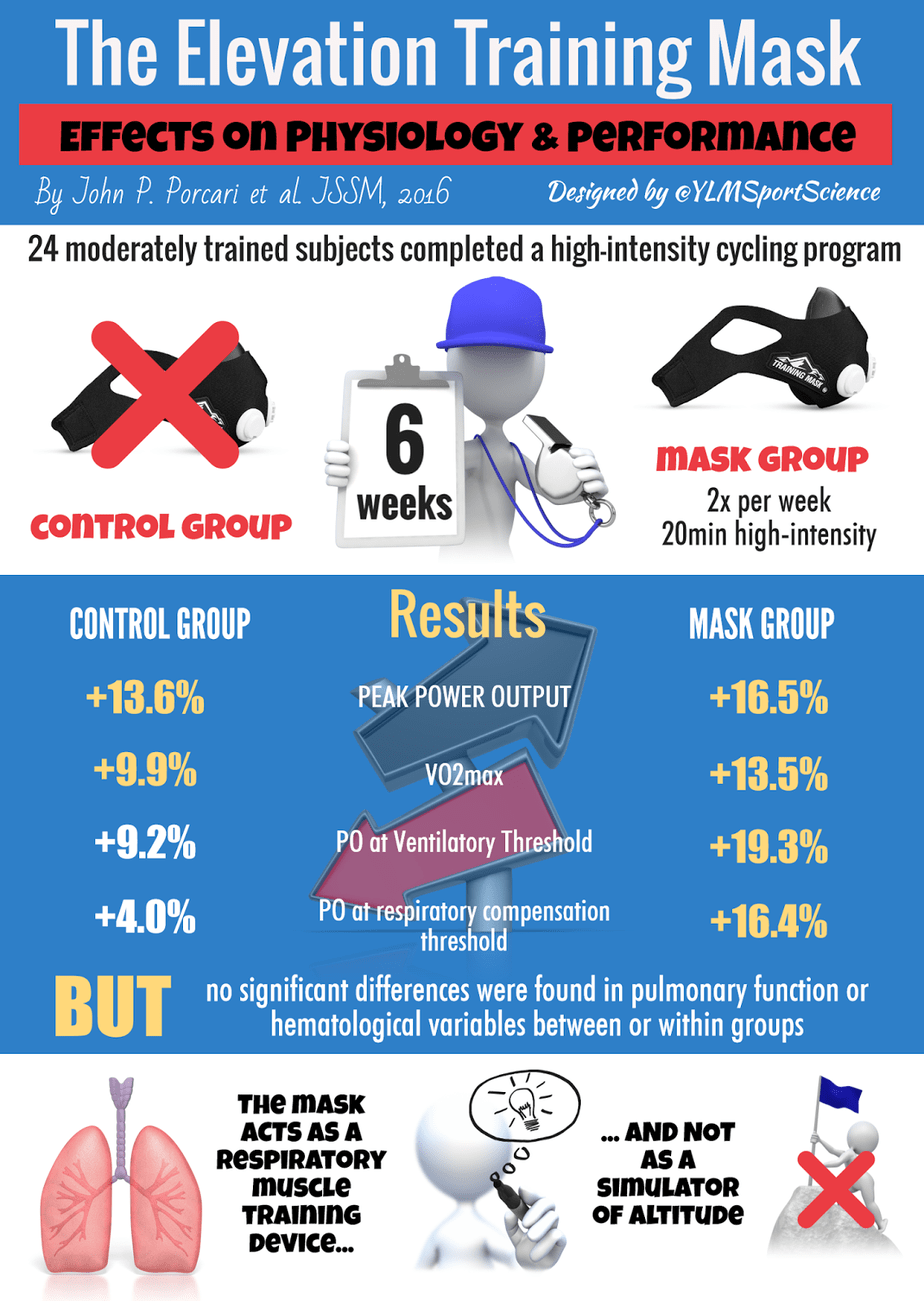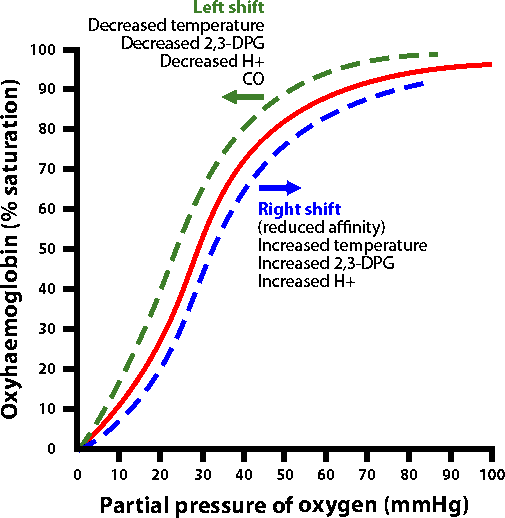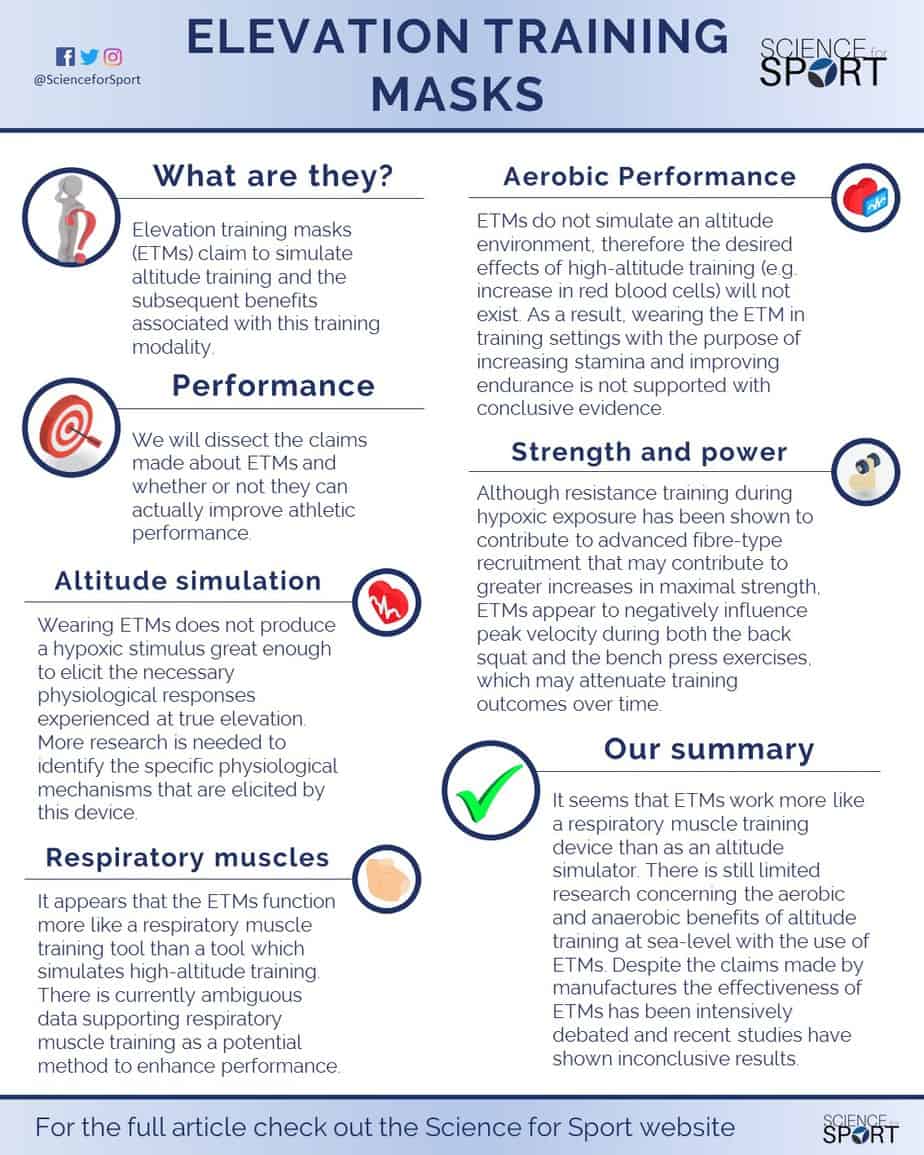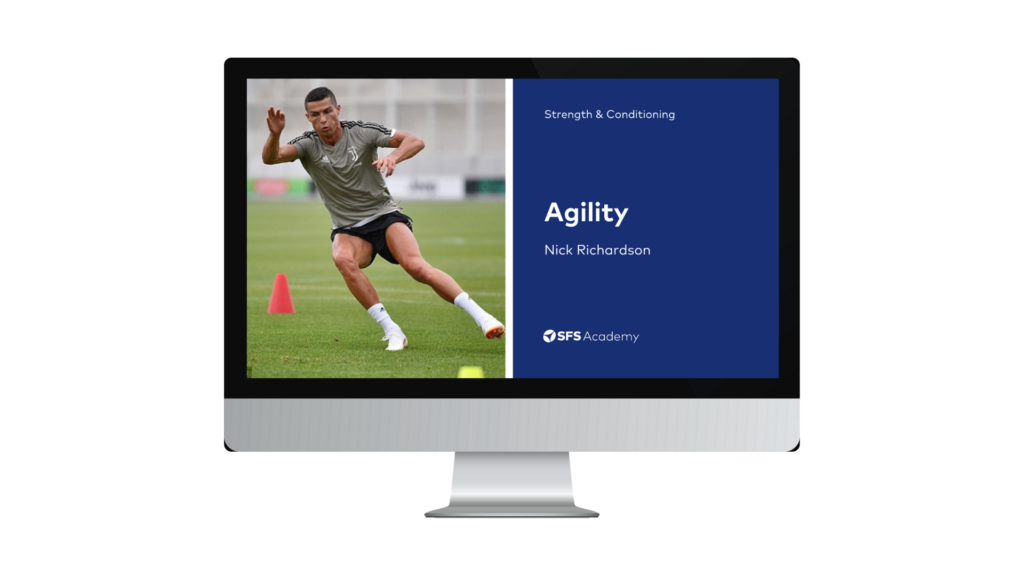Contents of Article
- Summary
- How does oxygen impact exercise?
- What is an altitude training mask?
- Do altitude training masks improve performance?
- Is future research needed with altitude training masks?
- Conclusion
- About the Author
- References
Summary
Several approaches and modalities have been used to simulate altitude training at sea level. The convenience of these methods and the benefits on both aerobic and anaerobic capacity have increased the number of athletes and non-athletes that use these approaches.
Among the novel methods, the Altitude Training Mask is a device that is claimed to simulate the benefits of altitude training. Moreover, a higher number of elite athletes have started using them in search of a competitive advantage/edge. Whether the Altitude Training Mask works as it is claimed has been intensively debated and recent studies have shown inconclusive results.

How does oxygen impact exercise?
Before we begin, it is important to clarify some of the common terminologies that will be present throughout this article:
- Hypoxia – a state where the tissue demand for oxygen exceeds the supply of oxygen.
- Hypoxic – is described as breathing a gas mixture which contains less than 21 % oxygen.
- Normobaric – a state of normal barometric pressure equivalent to that at sea level.
- Hypobaric hypoxia – is a condition where low pressure and reduced oxygen availability is present (e.g. high-altitude).
- Normobaric hypoxia – is a condition where normal pressure but reduced oxygen availability is present at terrestrial altitude (e.g. simulated altitude).
- Altitude training – is a training method used in an environment with a reduced partial pressure of oxygen. The aim is for the body to produce a greater amount of erythropoietin (EPO), which increases the number of red blood cells produced in the body.
Exercising aerobically [1] and anaerobically [2, 3] at altitude has been proven to increase VO₂ max, as well as enhance many other physiological adaptations (e.g. increased muscular power and hypertrophy). Several approaches and modalities have therefore been utilised to simulate altitude training, including normobaric hypoxia via nitrogen dilution (hypoxic department); supplemental oxygen; hypoxic sleeping devices; and intermittent hypoxic exposure [4]. Furthermore, simulated altitude training has become increasingly popular for its convenience as opposed to a cold environment, harsh terrain, and low-oxygen pressure that often accompanies high-altitude training [4].
In previous years, the various equipment used to induce hypoxia has been expensive, however, with the purpose of making this modality of training available to the broad public, new and more affordable devices have been introduced to simulate the same effects as elevation training in a more familiar environment [1]. Doing so makes it more convenient for athletes to get similar effects without having to travel to high-altitude environments [4].
One of these devices, the altitude training mask (ATM), is said to simulate altitude and induce a normobaric hypoxic condition, or minimise the amount of air allowed to be consumed by an individual [1]. An ETM is a patented pulmonary resistance training device that is currently a pioneer on the market. This device covers the user’s mouth and restricts air intake into dual channels and has an additional vent for the discharge of exhaled air.
Additionally, the mask includes a variety of adjustable resistance caps, as well as three adjustable flux valves. Furthermore, the individual can progressively increase the resistance to simulate from 900 to 5,400 meters (m) above sea level [4].
What is an altitude training mask?
The altitude training mask (ETM), also known as an elevation training mask or a ventilatory training mask, claims to enhance athletic performance by increasing endurance and VO₂ max; in addition to improving lung function [5]. The ETM is also said to simulate altitude and to induce a normobaric hypoxic condition [1].
The ETM provides adjustable resistances during inspiration with a set resistance on expiration in order to simulate high-altitude training (between 914 m to 5,486 m). The design of the mask restricts the oxygen flow using flux valves that limit the amount of air entering the mask, and therefore, the lungs [5].
Furthermore, it is suggested that the device can increase endurance and VO₂ max, as well as improve lung function [5]. Other common claims often used for marketing the ETM are that it:
- Simulates training at altitude
- Strengthens the respiratory muscles
- Increase stamina and improve endurance (aerobic performance)
- Increases strength and power (anaerobic performance)
As a result of these claims, we will now delve into scientific research and determine if any of them are true and if the ETM can have a positive effect on athletic performance.
Do altitude training masks improve performance?
In this section of the article, we will now discuss and dissect the claims made about ETM and whether or not they can actually improve athletic performance.
Simulates training at altitude
A common misconception among users of these masks is that the ETM simulates altitude by creating a hypobaric (reduced partial pressure of oxygen) environment [6]. For this to happen, however, the mask must have a mechanism to decrease the partial pressure of oxygen and therefore induce a hypoxic state during exercise [6]. Wearing the ETM does not produce a hypoxic stimulus great enough to elicit the necessary physiologic responses experienced at true elevation [6, 7] however, more research is needed to identify the specific physiological mechanisms that are elicited by this device [7].
Although inconclusive, the ETM’s flux valve system and resistance caps can reduce breathing frequency during exercise, which can potentially result in arterial hypoxemia (i.e. low levels of oxygen in the blood). This, in addition to a rebreathing of expired carbon dioxide, is likely to be responsible for the subsequent shift of the oxygen-dissociation curve (Figure 1 – [6]).
Oxygen-dissociation curve
The haemoglobin–oxygen dissociation curve is a graphical representation of the relationship between oxygen saturation and oxygen partial pressure. This representation helps us to understand the underlying processes of oxygen transportation to the tissues [8].
Strengthens the respiratory muscles
In line with the aforementioned, it has been suggested that rather than acting as a simulation of high altitude, the peripheral air resistance generated by the ETM may directly stress breathing musculature, therefore, acting more as a respiratory muscle training (RMT) device [6]. In theory, RMT may induce respiratory muscle fatigue and increase respiratory muscle strength, lung capacity, and oxygen efficiency over time [5].
It is suggested that RMT may improve respiratory muscle strength and endurance as a result of an increase in cellular oxidative adaptations [9], which, in turn, can lead to a delayed onset of metabolic acidosis [11]. The resulting lower levels of blood lactate during exercise, as well as the reduced perception of respiratory effort after RMT, may ultimately lead to an increase in physical performance [10].
In addition, wearing the ETM may result in significant increases in ventilatory threshold (VT) and power output at VT. Given this, no changes have been found in haematological variables before or after training. This suggests that the ETM functions more like an RMT than a tool that simulates high-altitude training [5].
Having said this, there is currently ambiguous data supporting the RMT as a potential method to enhance physical performance. Several findings suggest that improvements in RMT in respiratory muscle function are not transferable to VO₂ max or endurance exercise capacity [9, 10, 11]. There is little knowledge surrounding RMT in the literature regarding its benefits on exercise performance, or its effects on respiratory parameters [10, 11].
Increase stamina and improve endurance (aerobic performance)
Using the ETM has shown to cause arterial hypoxemia, but in a different way compared to real altitude training. Using the mask causes inadequate ventilation, resulting in an imbalance between oxygen uptake and CO2 removal, and can, therefore, lead to hyperventilation. This, in turn, causes the ETM to increase the perceived exertion while training [7].
Furthermore, when attempting to use the ETM in order to increase an individual’s VO₂ max, studies have shown inconclusive results. For example, some studies have found no significant difference in VO₂ max by wearing the mask [4, 12]. On the other hand, another study found an increase in VO₂ max in subjects wearing the mask, but importantly, it also found improvements in those who did not wear the ETM [5].
It has also been stated the ETM does not elicit a response for improving cardiorespiratory fitness [1]. In line with this, as the ETM does not simulate an altitude environment, the desired effects of high-altitude training (e.g. increase in red blood cells) will not exist [1]. As a result, wearing the ETM in training settings with the purpose of increasing stamina and improving endurance is not supported by conclusive evidence.
Increases strength and power (anaerobic performance)
Finally, ETM is claimed to help athletes achieve better performance during high-intensity interval training and strength training, under the assumption that oxygen restriction may result in adaptations relating to an enhanced buffering capacity [6].
This is also currently inconclusive and more research is needed to know if the ETM would compromise the ability to train at intensities high enough to elicit such adaptations [6]. Moreover, its use does appear to negatively influence peak velocity during both the back squat and the bench press exercises, which may attenuate training outcomes over time [6].
Whether strength training under hypoxic conditions can improve performance has recently been studied with promising results in terms of hypertrophy and muscular power [2, 3, 13]. Additionally, resistance training during hypoxic exposure has been shown to contribute to advanced fibre-type recruitment that may contribute to greater increases in maximal strength [14].
However, in terms of the ETM and strength training, limited research is available regarding adaptations in strength and power performance when using the ETM. A study published in 2017 suggested that wearing the ETM while performing a strength training session appears to not only hinder the ability to maintain working velocity during the bouts but also affect the athlete’s ratings of alertness and focus for the task [6].

Is future research needed with altitude training masks?
More research is needed to clarify the specific effects of the ETM on the different claims used for its marketing. For example, research is needed to clarify the following:
- The true mechanisms behind the simulated altitude training and how similar/effective it is compared to other hypobaric methods.
- The relationship between the ETM and athletic performance (e.g. endurance and strength) and how the different features that are enhanced by the mask serve for a better performance.
- Which athletes/ sports may benefit the most from this training method?
Conclusion
Although more research is needed, it seems ETMs work more as a respiratory muscle training device than as an altitude simulator. Moreover, there is still limited research concerning the aerobic and anaerobic benefits of altitude training at sea level with the use of an ETM.
Furthermore, the gap in knowledge also extends to the effects of ETM on long-term health and cardiorespiratory fitness. Despite the claims made by ETM manufacturers and marketers in terms of improved endurance and strength capacities, the effectiveness of the ETM has been intensively debated and recent studies have shown inconclusive results.
Finally, even though a larger number of elite and non-elite athletes have started to use the ETM to try and gain a competitive edge, it is vital they understand the science behind the technology and whether or not they have actually been shown to work before using and marketing these products themselves.
- Biggs, N. C., England, B. S., Turcotte, N. J., Cook, M. R., & Williams, A. L. (2017). Effects of Simulated Altitude on Maximal Oxygen Uptake and Inspiratory Fitness. Int J Exerc Sci, 10(1), 127-136. https://www.ncbi.nlm.nih.gov/pmc/articles/PMC5214464/
- Kon, M., Ikeda, T., Homma, T., Akimoto, T., Suzuki, Y., & Kawahara, T. (2010). Effects of acute hypoxia on metabolic and hormonal responses to resistance exercise. Med Sci Sports Exerc, 42(7), 1279-1285. https://www.ncbi.nlm.nih.gov/pubmed/20019623
- Feriche, B., Garcia-Ramos, A., Calderon-Soto, C., Drobnic, F., Bonitch-Gongora, J., Galilea, P., Riera, & Padial, P. (2014). PLoS One. 2014 Dec 4;9(12):e114072. https://www.ncbi.nlm.nih.gov/pubmed/25474104
- Warren, B., Spaniol, F. & Bonnette, R. (2017) The Effects of an Elevation Training Mask on VO2max of Male Reserve Officers Training Corps Cadets. Int J Exerc Sci 10(1): 37- 43. https://digitalcommons.wku.edu/cgi/viewcontent.cgi?article=1833&context=ijes
- Porcari, J. P., Probst, L., Forrester, K., Doberstein, S., Foster, C., Cress, M. L., & Schmidt, K. (2016). Effect of Wearing the Elevation Training Mask on Aerobic Capacity, Lung Function, and Hematological Variables. J Sports Sci Med, 15(2), 379-386. https://www.ncbi.nlm.nih.gov/pubmed/27274679
- Jagim AR, Dominy TA, Camic CL, Wright G, Doberstein S, Jones MT, Oliver JM. (2018) Acute Effects of the Elevation Training Mask on Strength Performance in Recreational Weight lifters. J Strength Cond Res. 2018 Feb;32(2):482-489. https://www.ncbi.nlm.nih.gov/pubmed/29084093
- Granados J., Gillum T.L., Castillo W., Christmas K.M., Kuennen M.R. (2016) Functional respiratory muscle training during endurance exercise causes modest hypoxemia but overall is well tolerated. Journal of Strength and Conditioning Research 30(3), 755-762. https://www.ncbi.nlm.nih.gov/pubmed/26340471
- Collins, J.S., Rudenski, A.S., Gibson, J., Howard, L., & O’Driscoll, R. (2015). Relating oxygen partial pressure, saturation and content: the haemoglobin–oxygen dissociation curve. Breathe. https://www.ncbi.nlm.nih.gov/pubmed/26632351
- Williams, J. S., Wongsathikun, J., Boon, S. M., & Acevedo, E. O. (2002). Inspiratory muscle training fails to improve endurance capacity in athletes. Med Sci Sports Exerc, 34(7), 1194-1198. https://www.ncbi.nlm.nih.gov/pubmed/12131262
- Sperlich,B., De Mareés, M., Linville, J. & Mester, J. (2009) Does Respiratory Muscle Training Increase Physical Performance? Military Medicine, Vol. 174, September 2009. https://www.ncbi.nlm.nih.gov/pubmed/19780375
- Sonetti, D. A., Wetter, T. J., Pegelow, D. F., & Dempsey, J. A. (2001). Effects of respiratory muscle training versus placebo on endurance exercise performance. Respir Physiol, 127(2-3), 185-199. https://www.ncbi.nlm.nih.gov/pubmed/11504589
- Maher, M. (2016) The Effects of Simulated Altitude Training on Aerobic Capacity and Function. (Master’s Thesis) New Jersey. William, Paterson University. https://www.researchgate.net/publication/323341986_The_Effects_of_Simulated_Altitude_Training_on_Aerobic_Capacity_and_Function
- Kurobe, K., Huang, Z., Nishiwaki, M., Yamamoto, M., Kanehisa, H., & Ogita, F. (2015) Effects of resistance training under hypoxic conditions on muscle hypertrophy and strength. Clin Physiol Funct Imaging. 2015 May;35(3):197-202. https://www.ncbi.nlm.nih.gov/pubmed/24690432
- Scott, B., Slattery, K. & Dascombe, B. (2014) Intermittent hypoxic resistance training: does it provide added benefit? Front Physiol. 2014; 5: 397. https://www.ncbi.nlm.nih.gov/pmc/articles/PMC4195285/






